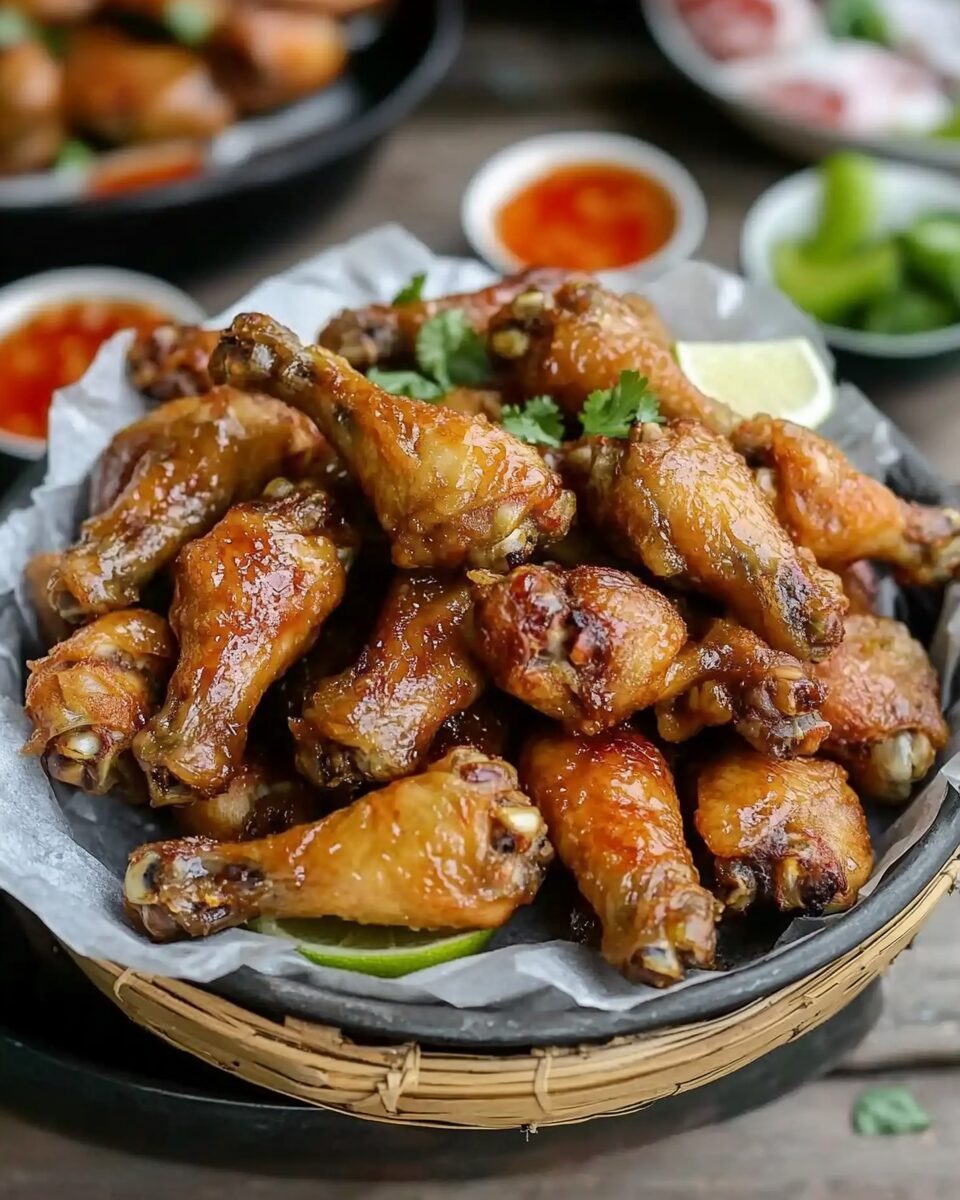The Magic Behind Vietnamese Fish Sauce Wings
The incredible flavor of these wings comes from the careful balance of each element. Fish sauce, the soul of Vietnamese cuisine, provides a deep, savory umami backbone that is beautifully complemented by the sweetness of sugar and the brightness of lime. The garlic and shallots bring a fragrant, savory punch, creating a complex yet approachable glaze. Frying the wings first ensures they stay crispy even after being coated in the sticky sauce. Each bite is a perfect explosion of crispy skin, juicy meat, and a richly layered glaze that is slightly sweet, enticingly salty, and deeply satisfying.
Why You’ll Love This Dish
Vietnamese Fish Sauce Chicken Wings are truly a crowd-pleaser, beloved by anyone who loves bold and balanced flavors. They are easy enough to prepare at home but taste like a restaurant-quality treat. The glaze is sticky and flavorful without being overwhelmingly heavy, making them ideal for snacking or pairing with a variety of side dishes. They are highly versatile, fitting seamlessly into casual family meals, festive gatherings, game day spreads, or potlucks. Because they are naturally packed with flavor, they require very few additional accompaniments to make an outstanding dish.
Tips for Making the Best Fish Sauce Wings
To achieve the ultimate crispy texture, make sure the chicken wings are as dry as possible before coating them in the flour-cornstarch mixture. Letting the coated wings sit for 30 minutes before frying allows the flour to hydrate slightly, resulting in a more cohesive, crunchy crust. Maintaining the oil temperature at a steady 350°F is crucial for achieving a golden, crispy exterior without overcooking the meat inside. When preparing the glaze, simmer it gently until it reduces to a syrupy consistency to ensure it clings perfectly to the wings. Toss the wings in the glaze while they are still hot for maximum flavor absorption.
Common Mistakes to Avoid
One of the most common mistakes is overcrowding the frying pot, which lowers the oil temperature and results in soggy, greasy wings. Always fry the wings in batches to maintain consistent heat. Another pitfall is not reducing the glaze enough; a watery glaze will slide off the wings rather than sticking to them. Make sure to cook the sauce until it thickens and becomes slightly sticky. Overcooking the garlic can also introduce a bitter flavor to the glaze, so be sure to sauté it gently until just fragrant. Lastly, skipping the lime juice finish can cause the wings to taste overly rich without the needed pop of acidity.
Serving Suggestions
Vietnamese Fish Sauce Chicken Wings are a complete flavor bomb on their own but can be complemented by a variety of sides for a more complete meal. Serve them with a simple side of steamed jasmine rice to soak up any extra glaze. Fresh vegetable sticks like cucumber, carrots, and daikon radish help balance the richness and add a cooling crunch. A crisp cabbage slaw dressed with a light vinaigrette also pairs beautifully, offering a refreshing contrast to the bold wings. For a more festive spread, consider serving them alongside other Vietnamese favorites like spring rolls, papaya salad, or vermicelli noodle bowls.
Adaptations and Variations
There are several ways to customize this dish to suit your preferences. If you prefer a spicier kick, add chopped Thai red chilies to the glaze or sprinkle chili flakes over the finished wings. For a gluten-free version, replace the all-purpose flour with a gluten-free flour blend. To make a lighter version, the wings can be air-fried or baked in a high-heat oven instead of deep-frying, though the texture may vary slightly. You can also experiment with different flavor profiles by adding a splash of soy sauce or hoisin sauce to the glaze for an extra layer of complexity.
The Cultural Significance of Fish Sauce in Vietnamese Cuisine
Fish sauce, or nước mắm, is the backbone of Vietnamese cuisine, lending depth, umami, and complexity to countless dishes. It is made from fermented anchovies and salt, creating a robust and savory seasoning that is indispensable in Vietnamese cooking. In dishes like Cánh Gà Chiên Nước Mắm, fish sauce is not just an accent; it is the star, providing an intense flavor that harmonizes beautifully with sugar, lime, and aromatics. This dish exemplifies the Vietnamese culinary philosophy of balancing the five fundamental flavors—sweet, salty, sour, bitter, and umami—to create a dish that is greater than the sum of its parts.
Nutritional Information
Each serving of Vietnamese Fish Sauce Chicken Wings contains about 370 calories, offering a good balance of protein and fat, making them a satisfying option for a hearty appetizer or main course. With 24 grams of protein per serving, they contribute to muscle repair and satiety, while the 22 grams of fat, including some saturated fats, contribute to the rich mouthfeel that makes fried chicken so indulgent. The wings are also a source of potassium and small amounts of iron and calcium. While higher in sodium due to the fish sauce, balancing them with plenty of fresh vegetables and light sides makes them an enjoyable treat within a varied diet.
Conclusion
Vietnamese Fish Sauce Chicken Wings are a sensational dish that captures the essence of Vietnamese cooking—bold, balanced, and utterly addictive. With their crispy fried exterior, juicy meat, and sticky, sweet-savory glaze, they offer an unparalleled eating experience that is both comforting and exciting. Perfect for parties, family gatherings, or even a special solo treat, these wings are guaranteed to be the star of any table. Their vibrant flavors, straightforward preparation, and cultural richness make them a dish worth savoring and sharing. Once you try these unforgettable wings, you’ll find yourself reaching for this recipe again and again.






